Abstract
Wellbeing and self-effectiveness depend on various factors and some of those are represented by the stressors of the workplace. The research questions is that the way in which the evolution of the stressors is perceived in time is an important tracking size or Frequency and severity of stressors are suficient to describe them. If it is importance of pursuing all three dimensions of both occupational and out-of-work stressors in order to evaluate the correlations between Subjective wellbeing and perceived self-effectiveness represent the purpose of this study. For the assessment of occupational stress and stress outside the workplace, a 36-item 3-dimension questionnaire (referring to frequency, level and evolution in time) was structured and administered to employees in a secondary school. At the same time, the 57 employees were surveyed for self-effectiveness and subjective wellbeing (TSWQ). TSWQ correlates positively with Self-Effectiveness (p = 0.00), with evolution of the inexible work program (p = 0.011). TSWQ correlates negatively with all the dimensions of stress represented by the problems affecting family: frequency (p = 0.034), level (p = 0.042) evolution (p = 0.042). These results underline the importance of pursuing all three dimensions of both occupational and out-of-work stressors. Both Subjective wellbeing and perceived self-effectiveness are primarily correlated with stressors outside the workplace. In secondary school employees, family problems have a negative influence primarily on Subjective wellbeing, whereas connecting relationships at home and personal life problems have a negative influence on self-effectiveness.
Keywords: Subjective wellbeingself-effectivenessevolution
Introduction
Self-effectiveness is based on the estimation of motivation and cognitive possibilities that a person holds to determine professional and personal life. Preda (2010) nominates the following categories of occupational stressors: content of professional activity, temporal pressure, required quality, monotony, lack of control over work organization, poor planning, unclear tasks, volatility of positions, lack of support from colleagues and / or superiors, role conflicts, inefficient management, insufficient job ergonomization, insufficient material resources, positioning the school in a low socio-economic and socio-cultural environment. Teachers’ cognitive wellbeing is associated with teacher positive psychological functioning (Arslan, 2018) and can represent a protective factor to stress. A well -known questionnaire, constructed to measure generic sources of occupational stress, Job Stress Survey (JSS), evaluates thirtieth occupational stressors on the basis of frequency and severity (Vagg & Spielberger, 1999). The distinction between severity and frequency is similar to the differentiation between state and traits anxiety. When severity and frequency of stressors are taken into account they describe a more exact picture of the experienced occupational stress (Holmström, Molander, Jansson, & Barnekow-Bergqvist, 2008).
Problem Statement
Wellbeing and self-effectiveness depend on various factors and some of those are represented by the stressors of the workplace or by the stressors outside the workplace. Wellbeing and self-effectiveness are associated with stressors outside the workplace, for example those related to the family, problems of the known ones, personal health and the health of the circle of friends or close persons.
Research Questions
The way in which the evolution of the stressors is perceived in time is an important tracking size or only Frequency and severity of stressors are sufficient to describe them. Wellbeing and self-effectiveness are associated with stressors inside or outside of workplace.
Purpose of the Study
If it is importance of pursuing all three dimensions of both occupational and out-of-work stressors in order to evaluate the correlations between Subjective wellbeing, perceived self-effectiveness and and stressors inside or outside of workplace.
Research Methods
For the assessment of occupational stress and stress outside the workplace, a 36-item 3-dimension questionnaire (referring to frequency, level and evolution in time) was structured and administered to employees in a secondary school. At the same time, the 57 employees were surveyed for self-effectiveness and subjective wellbeing (TSWQ). The workplace nominated stressors were the following: work tasks, work schedule, unable to change unpleasant aspects, communication with superiors, communication with other employees, wage level, risks of disease, risks of injury (Triff & Bocos, 2017). We added two stressors known as specific and predominant in education: difficulties in collaborating with students or with pupils' parents (Preda, 2010).
Other types of stressors added were the following: - presence of diseases that limit the employee's work ability (one item);
- Inappropriate class / school microclimate (temperature, noise, etc.) (one item);
- High activity periods (assessments, exams etc.) (one item);
- Verbal aggression (threats, mockery) addressed to the respondent (one item);
-The presence of gossip circles about my person (one item), presence of gossip circles targeting other employees (one item);
- the presence of verbal aggression targeting other employees (one item);
-Violence from other employees (one item); violence of students (one item), parents violence (one item);
-Limitation of personal priorities (one item);
-discrimination / harassment (sex, ethnicity; religion) (one item);
- the presence of colleagues' remarks (one item);
-other sources of stress (one item)
6 stressors apply only to teachers as follows:
- insufficient resources in school;
-inflexible school curriculum;
-oversized school curriculum;
-restrictive school regulations;
- the difficulty of ensuring classroom discipline;
-large number of pupils in class.
Each item had 3 dimensions of stressor-specific response:
-frequency, with variants not at all (coding = 0), sometimes (coding = 1), frequently (coding = 2);
-level, with response options: absent (coding = 0), small (coding = 1), medium (coding = 2) high (coding =3)
- comparison with the previous year with response options: smaller (coding = 1), the same (coding = 2), higher (coding = 3).
The questionnaire, abbreviated as FLC (from the studied dimenisons, i.e. frequencies, level, comparison), was administered within one day, for voluntary, anonymous completion, as part of the regular medical check-up in October 2017, in a secondary school. From the 59 employees, 54 attended and returned the received questionnaires.
The questionnaire representing the General Self-Efficacy Scale ("General self-efficacy scale") was used to assess perceived personal effectiveness (Baban, Schwarzer, & Jerusalem, 1996; General Self-Efficacy Scale, 1996).
The teachers’ subjective wellbeing was measures using TSWQ (Teachers’ subjective wellbeing questionnaire) that is a validated instrument used for measuring the teachers’ subjective wellbeing, with 8 items and Likert-scale answers ranging from "Almost Never" to... "Almost Always". In this scale scores result by summing item responses, higher scale scores represent greater levels of teacher wellbeing. Teachers’ subjective wellbeing questionnaire has two subscales: School Connectedness Scale and Teaching Efficacy Scale.
Coding used for statistical processing in this scale and its subscales were as follow: almost never (=1), Sometimes (=2), Often (=3), Almost Always (=4). After the employees completed the mentioned questionnaires, they were given a set of 7 questions that nominated stressors outside the workplace, having the same 3 dimensions as the stressors present in the workplace (frequency, level, comparison with the previous year). The items presented in this last questionnaire, containing sources of stress outside the workplace, only by dimension of frequency, were as follows:
-Problems that have arisen in personal life,
-Relationships (conflicts) with those I live with,
-Problems of the close ones,
-Personal health problems,
-The health problems of the close ones,
-Other.
For purposes of statistical processing, questionnaire answers to some variables (representing individual characteristics of employees) were coded (Table
Findings
Distribution by type of residence and sex is shown in the following figure
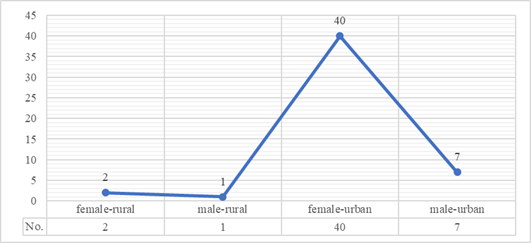
Age distribution by type of residence and sex is shown in the following figure, with no statistically significant differences (by sex and residence) (Figure
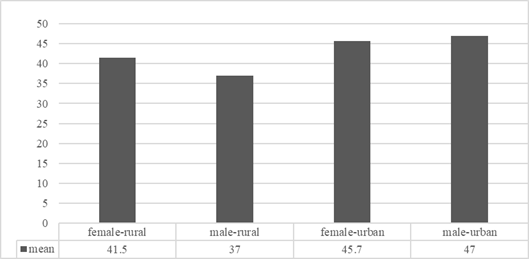
The first twelve stressors distribution by frequence, level and evolutionary perception in school is shown in Figure
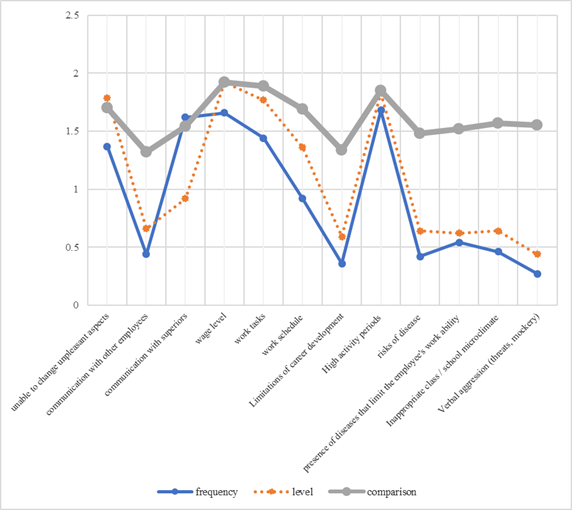
The first three frequency of occupational stressors occupied places as follows: communication with superiors, communication with other employees, wage level, high activity periods. The first three highest levels of stressors in school are represented by the following wage level, work tasks, unable to change unpleasant aspects. According to evolutionary perception the first three stressors are the following: wage levels, work tasks, high activity periods.
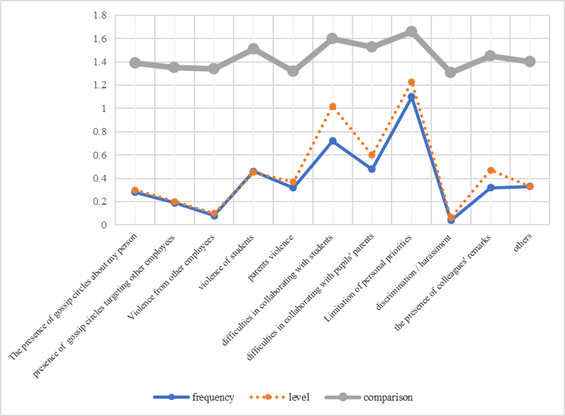
Six stressors related with didactic activity show that fist tree places, by all dimensions (frequency, level and comparison), are in decreasing order oversized school curriculum, inflexible school curriculum, insufficient resources in school (Figure
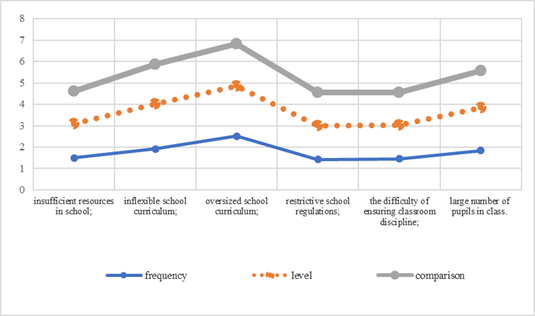
In TSWQ scores of items does not differ significantly, anyway, the first aspect seems to be "the respect of treatment" for teacher (Figure
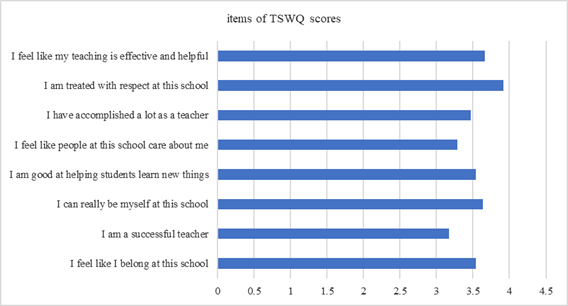
The main sources of stress outside the workplace by dimension of frequency are "the health problems of the close ones " and "problems that have arisen in personal life "(Figure
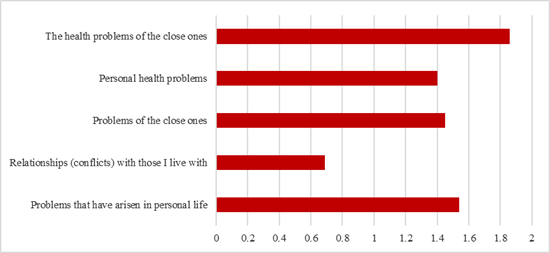
There are numerous correlation between occupation stressors dimensions (frequency, level, comparison) and thus these can not be presented in present article.
Self-efficacy correlates positively with the TSWQ score (p = .000) and negatively with the stressor evolution of both the wage level (p = 0.003) and the work schedule (p = 0.010). At the same time, there are many differences in the perception of stressors according to the individual characteristics of the workers
The TSWQ score correlates significantly negatively with the frequency of the difficulty of collaborating with the pupils (p = 0.008), the frequency of the insufficient means provided by the school to perform the didactic activity (p = 0.044), the frequency of the difficulty of ensuring student discipline in the classroom (p = 0.001), the level of difficult collaboration with students (p = 0.038), level of constraints related to limiting school regulations (p = 0.026) and the evolution dimension of inflexible work schedule (p = 0.011).
Conclusion
There are numerous correlation between occupational on outside workplace stressors all three dimensions (frequency, level, comparison).
These results underline the importance of pursuing all three dimensions of both occupational and out-of-work stressors.
Both Subjective wellbeing and perceived self-effectiveness are primarily correlated with stressors outside the workplace.
In secondary school employees, family problems have a negative influence primarily on Subjective wellbeing, whereas conflicting relationships at home and personal life problems have a negative influence on self-effectiveness.
References
- Arslan, G. (2018). Understanding the Association between Positive Psychological Functioning at Work and Cognitive Wellbeing in Teachers. Journal of Positive Psychology and Wellbeing, 2(2), 113–127.
- Baban, A., Schwarzer, R., & Jerusalem, M. (1996). General Self-Efficacy Scale. Retrieved from http://userpage.fu-berlin.de/~health/rumania.htm
- Holmström, S., Molander, B., Jansson, J., & Barnekow-Bergqvist, M. (2008). Evaluation of a Swedish version of the Job Stress Survey. Scandinavian Journal of Psychology, 49, 277–286.
- Preda, V. R. (2010). Effects of stress and coping strategies on teachers and pupils. (PhD Thesis). Babes Bolyai University, Faculty of Psychology and Education Sciences.
- Triff, D., & Bocos, M. (2017). Correlations between work ability, occupational stress factors and health in primary and secondary education, in: Modern Research in Health, Education and Social Sciences. From Evaluation to Intervention, (coord Milcu M., Stevens M., Dahl I.), Editura Universitară București, 2017.
- Vagg, P. R., & Spielberger, C. D. (1999). The Job Stress Survey: Assessing perceived severity and frequency of occurrence of generic sources of stress in the workplace. Journal of Occupational Health Psychology, 4(3), 288-292.
Copyright information

This work is licensed under a Creative Commons Attribution-NonCommercial-NoDerivatives 4.0 International License.
About this article
Publication Date
07 November 2019
Article Doi
eBook ISBN
978-1-80296-071-6
Publisher
Future Academy
Volume
72
Print ISBN (optional)
-
Edition Number
1st Edition
Pages
1-794
Subjects
Psychology, educational psychology, counseling psychology
Cite this article as:
Triff, D., & Bocoș, M. (2019). Subjective Wellbeing And Self Effectiveness In Secondary School Through Three Stressors Dimensions. In P. Besedová, N. Heinrichová, & J. Ondráková (Eds.), ICEEPSY 2019: Education and Educational Psychology, vol 72. European Proceedings of Social and Behavioural Sciences (pp. 549-557). Future Academy. https://doi.org/10.15405/epsbs.2019.11.64

